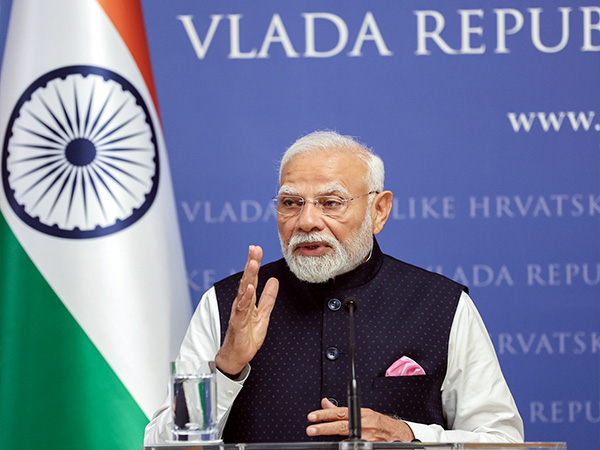India stands secure and self-reliant than ever before

New Delhi [India], June 19 (ANI): India’s firm and clear-eyed approach to internal security and counter-terrorism over the last eleven years reflects the government’s unwavering resolve to prioritise national interest above all. From precision military strikes across borders to strategic dismantling of insurgent networks within, India has shed the hesitations of the past.
As per an official statement from the government of India, a clear doctrine now guides action, swift, decisive and backed by intelligence. With the abrogation of Article 370, the campaign against Naxalism, and new capabilities in high-tech defence, India today stands more secure and self-reliant than ever before. Operation SINDOOR, India’s swift and precise military response to a terror attack in April 2025, further demonstrated this resolve. These successes are a result of political will, military strength and a deeply rooted belief in putting the country first.
India responded to the terrorist attack in Uri on 18 soldiers by conducting Surgical Strikes on 28-29 September 2016. These strikes inflicted heavy losses on terrorists and their protectors across the Line of Control. A few years later, on 14 February 2019, the Pulwama terror attack claimed 40 CRPF jawans. India’s response came swiftly. On 26 February 2019, in an intelligence-led operation, the Balakot airstrikes eliminated a large number of Jaish-e-Mohammad terrorists, including senior commanders. The facility targeted was located far from civilian areas and headed by Maulana Yousuf Azhar, brother-in-law of JeM chief Masood Azhar. These pre-emptive actions showed the world that India would no longer tolerate proxy wars through terrorism.
In April 2025, following a brutal terror attack on civilians in Pahalgam, India launched Operation SINDOOR, executing precise retaliatory strikes against nine terrorist camps in Pakistan and Pakistan-occupied Jammu and Kashmir. The Indian military, acting on accurate intelligence, relied on drone strikes, loitering munitions, and layered air defence to neutralise key threats without crossing international boundaries. When Pakistan launched drone and missile attacks on 7-8 May against multiple Indian cities and bases, these were swiftly intercepted, showcasing the effectiveness of India’s net-centric warfare systems and integrated counter-UAS (unmanned aerial systems) grid.
In his address to the nation, Prime Minister Narendra Modi reiterated India’s firm policy on cross-border terrorism and its approach towards Pakistan. He underlined that national security is non-negotiable and outlined clear red lines regarding dialogue, deterrence, and defence.
He said that any terrorist attack on India will be met with a fitting and decisive response, regardless of where the perpetrators operate from and India will not be deterred by nuclear threats and will continue to carry out precise strikes against terrorist hideouts.
He further made it clear that there will be no difference between the masterminds and the sponsors of terror; both will be held accountable, adding that any engagement with Pakistan, if at all, will be focused only on terrorism or the issue of Pakistan-occupied Kashmir. The Prime Minister declared, “Terror and talks cannot go together, terror and trade cannot go together, and water and blood cannot flow together,” firmly closing the door to normal relations amid terror threats.
On 5 August 2019, Parliament approved the removal of Articles 370 and 35-A, marking a historic correction of a decades-old imbalance. Jammu & Kashmir and Ladakh were brought at par with other regions, and over 890 Central laws were applied. As many as 205 state laws were repealed, and 130 were modified to align with the Constitution of India.
Since then, development in the region has accelerated. Marginalised groups like Valmikis, Dalits, and Gorkhas now enjoy full rights. Laws such as the Right to Education and Child Marriage Act now protect all citizens in the region. The impact is clear: terrorist-initiated incidents have dropped from 228 in 2018 to just 28 in 2024, demonstrating a strong correlation between integration and peace.
The multi-pronged approach to Left Wing Extremism has delivered historic gains. From 126 affected districts in 2010, the number has come down to just 38 by April 2024. Most affected districts were reduced from 12 to 6, and the number of casualties is at a 30-year low. Violence has declined sharply from 1,936 incidents in 2010 to 374 in 2024, a drop of 81 cent. Deaths have reduced by 85 cent over the same period.
In 2024 alone, 290 Naxals were neutralised, 1,090 arrested, and 881 surrendered. Major recent operations in March 2025 saw 50 Naxals surrender in Bijapur, 16 neutralised in Sukma, and 22 killed in Kanker and Bijapur. With continued support through Special Central Assistance and targeted development, the government is on track to eliminate Naxalism by 31 March 2026.
India’s journey over the past 11 years showcases its transformation into a confident global power. Through strategic initiatives, from the G20 presidency to the International Solar Alliance, India has led with purpose and pragmatism. Its commitment to humanitarian aid, regional partnerships, and counter-terrorism reflects a nation that places its people first while contributing to global stability. With a focus on self-reliance, from defence production to technological innovation, India has strengthened its sovereignty and global standing. This era of bold leadership and inclusive diplomacy positions India as a pivotal force in shaping a balanced, prosperous world order. (ANI)
This story is not been edited by Take One Television & Digital Network Staff and is auto-generated from syndicated feed






